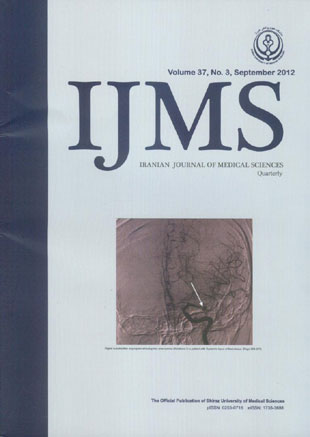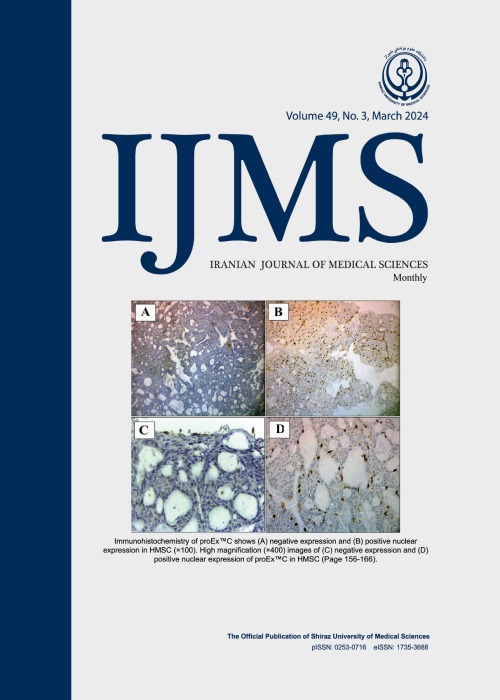فهرست مطالب

Iranian Journal of Medical Sciences
Volume:37 Issue: 3, Sep 2012
- 80 صفحه،
- تاریخ انتشار: 1391/07/01
- تعداد عناوین: 14
-
-
Page 150Vascular diseases of the brain are the second reason of the death and the first cause of morbidity and disability worldwide. In tropical areas stroke has some particular features related to the nature of torrid zones. There are some special causes of the stroke, mainly infectious, although some of them are non-infectious. The most important etiologies are malaria, tuberculosis, cysticercosis, syphilis, and Chagas’ disease. The mean age of the patients with stroke in tropical areas seems to be less than that in developed countries, and the disease is more prevalent in younger adults. Prevention and/or treatment of the classic risk factors as well as factors related to tropical zones are the mainstays of controlling the disease. It has to be mentioned that lack of human as well as financial resources makes it difficult to control and treat the disease properly. Herein, the etiologies and risk factors of the cerebrovascular diseases in tropical regions will be reviewd.Keywords: Stroke, infection, tropics, Iran
-
Page 159BackgroundDuring pregnancy and lactation outstanding changes occur in mother’s vitamin D metabolism. This study was carried out to evaluate the efficacy of 300,000 IU vitamin D given intramuscularly on body status in new cases of gestational diabetes mellitus (GDM).MethodsThis is a randomized clinical trial with the follow-up period of 3 months. Totally 45 participants were randomly divided into intervention group (IG) and control group (CG). The IG received an IM injection of 300,000 IU of vitamin D, whereas CG did not. The glycosylated hemoglobin A1C (HBA1C), serum 25-OH-D, parathyroid hormone (PTH), serum calcium and phosphorus were measured.ResultsForty five patients including 24 with the mean age of 30.7±6.2 years in the IG and 21 with the mean age of 29.5±4.0 years in the CG participated in the study. The median concentration of serum 25(OH)D3 in the IG was to 62.10 nmol/l after the intervention, showing an increase of around 158%, compared to before intervention (24.25 nmol/l) whereas the CG showed a decrease of around 4.5%. Of the patients, 79.2% of IG and 81.9% of CG suffered to some degree from vitamin D deficiency. These figures were 4.2% and 71.4% for the IG and CG, respectively after the intervention.For the IG, the PTH was significantly lower and Ca was significantly higher after the intervention. The serum Phosphorus before and after the intervention in each group or between the two groups was not significant.ConclusionsThe single 300,000 IM dose of vitamin D is regarded as an effective and safe to promptly improve vitamin D status in GDM.Keywords: Cholecalciferol, gestational diabetes mellitus, vitamin D
-
Page 166ackground: Nausea and vomiting are common complications of anesthesia and surgery. Patients undergoing tympanoplasty are exposed to a higher risk of postoperative nausea vomiting (PONV). These complications may alter the results of reconstruction and anatomical alignments. Numerous antiemetics have been studied to prevent and treat PONV in patients undergoing tympanoplasty. The aim of this study was to compare the effect of intravenous ondansetron and dexamethasone on post-tympanoplasty PONV.MethodsIn a double-blind randomized controlled clinical trial, 219 patients were divided into three groups including one receiving ondansetron, one receiving dexamethazone, and one receiving distilled water. All patients were subjected to tympanoplasty type I. The patients in the first group received ondansetron (4 mg IV), second group received oexamethasone (8 mg IV), and third group received distilled water prior to induction of anesthesia. Using Bellivelle’s scoring system, the incidence of PONV and its severity during the 24-hour period after surgery were measured and compared.ResultsThere was no significant difference among PONV in the three groups in the first two hours after the surgery. However, in 2-8, 8-16 and 16-24 hours after the surgery the PONV in ondansetron and dexamethasone groups were significantly lower than that in the control group.ConclusionOndansetron and dexamethasone were more effective than placebo in controlling PONV after tympanoplasty surgeries. Moreover, dexamethasone was more effective than ondansetron in preventing PONV.Keywords: Postoperative, Ondansetron, Dexamethasone, vomiting, tympanoplasty
-
Page 173BackgroundThe role of oxidative stress in endosulfan-induced reproductive toxicity has been implicated. This study was performed to evaluate the possible protective effect of vitamins E and C, against endosulfan-induced reproductive toxicity in rats.MethodsFifty adult male Sprague–Dawley rats were randomly divided into five groups (n=10 each). The groups included a control receiving vehicle, a group treated with endosulfan (10 mg/kg/day) alone, and three endosulfan-treated group receiving vitamin C (20 mg/kg/day), vitamin E (200 mg/kg/day), or vitamine C+vitamin E at the same doses. After 10 days of treatment, sperm parameters, plasma lactate dehydrogenase (LDH), plasma testosterone and malondialdehyde (MDA) levels in the testis were determined.ResultsOral administration of endosulfan caused a reduction in the sperm motility, viability, daily sperm production (DSP) and increased the number of sperm with abnormal chromatin condensation. Endosulfan administration increased testis MDA and plasma LDH. Supplementation of vitamin C and vitamin E to endosulfan-treated rats reduced the toxic effect of endosulfan on sperm parameters and lipid peroxidation in the testis. Vitamin E was more protective than vitamin C in reducing the adverse effects of the endosulfan.ConclusionThe findings data suggest that administration of vitamins C and E ameliorated the endosulfan-induced oxidative stress and sperm toxicity in rat. The effect of vitamin E in preventing endosulfan-induced sperm toxicity was superior to that of vitamin C.Keywords: Endosulfan_spermatogenesis_oxidative stress_vitamin E vitamin C
-
Page 181BackgroundUrtica dioica has been used as antihypertensive, antihyperlipidemic and antidiabetic herbal medicine. The purpose of this study was to study the effect of hydroalcoholic extract of Urtica dioica on fructose-induced insulin resistance rats.MethodsForty male Wistar rats were randomly divided into five groups including control, fructose, extract 50, extract 100 and extract 200. The control rat received vehicle, the fructose and extract groups received fructose 10% for eight weeks. The extract groups received single daily injection of vehicle, 50, 100 or 200 mg/kg/day for the two weeks. Blood glucose, insulin, last fasting insulin resistance index (FIRI), serum triglyceride (TG), low-density lipoprotein (LDL), very low-density lipoprotein (VLDL), high-density lipoprotein (HDL), alanin trasaminase (AST) and alkaline phosphatase (ALP), leptin and LDL/HDL ratio were determined.ResultsCompared to control group, daily administration of fructose was associated with significant increase in FIRI, blood glucose and insulin, significant decrease in lepin, and no significant change in TG, HDL, LDL, LDL/HDL ratio, VLDL, ALT, and ALP. The extract significantly decreased serum glucose, insulin, LDL and leptin, and LDL/HDL ratio and FIRI. It also significantly increased serum TG, VLDL, and AST, but did not change serum ALP.ConclusionWe suggest that Urtica dioica extract, by decreasing serum glucose, and FIRI, may be useful to improve type 2 diabetes mellitus. Also, by positive effect on lipid profile and by decreasing effect on leptin, it may improve metabolic syndrome.Keywords: Fructose, insulin resistance, Urtica dioica
-
Page 187BackgroundElectroporation is a valuable tool for small interfering RNA (siRNA) delivery into cells because it efficiently transforms a wide variety of cell types. Since electroporation condition for each cell type must be determined experimentally, this study presents an optimal electroporation strategy to reproducibly and efficiently transfect MDA-MB 468 human breast cancer cell with siRNA.MethodsTo identify the best condition, the cells were firstly electroporated without siRNA and cell viability was determined by trypan blue and MTT assays. Then siRNA transfection in the best condition was performed. Western blot analysis was used for monitoring successful siRNA transfection.ResultsThe best condition for electroporation of this cell line was 220 volt and 975 µF in exponential decay using the Gene Pulser X cell electroporation system. Our data demonstrated that by using proper electroporation condition, DNA methyl transferase mRNA was silenced by 10 nmol DNMT1 siRNA in MDA-MB 468 cells when compared with negative control siRNA electroporation. Analysis of cell viability demonstrated that optimal electroporation condition resulted in 74% and 78% cell viability by trypan blue staining and MTT assay, respectively.ConclusionTransfection of the MDA-MB-468 breast cancer cell line with siRNA in the obtained electroporation condition was successful and resulted in effective gene silencing and high cellular viability.Keywords: Small interfering RNA, electroporation, breast cancer
-
Page 194BackgroundBacteremia due to Enterococcus faecalis is usually caused by strains resistant to most antibiotics. Effective management of the disease is dependent on rapid detection and characterization of the bacteria, and determination its sensitivity pattern to antimicrobial drugs. The aim of this study was to investigate a more rapid and reliable assay for simultaneous diagnosis of enterococcal bacteremia and its sensitivity pattern to antimicrobial drugs.MethodsSeveral bacterial suspensions with different content of two standard strains of Enterococcus faecalis resistant to vancomycin were used for inoculation to defibrinated sheep blood samples. PCR and routine assay was performed on all blood samples with different bacterial content.ResultsRoutine assay and PCR for all inoculated blood samples with? 5 cfu/ml was positive. Mean time for PCR and routine assays was 10 hours and 5 days, respectively.ConclusionPCR is a more rapid and sensitive assay for simultaneous detection and characterization for Enterococcus faecalis, and determination of its sensitivity pattern to vancomycin.Keywords: Enterococcus faecalis, multiplex, PCR, Van A, Van B
-
Page 202Simultaneous dislocation of shoulder and humeral shaft fracture is a rare injury, and there is no clear protocol for its treatment. Herein we present a case of a 15-year-old boy, who suffered from a job-related accident and sustained fracture of humeral shaft associated with ipsilateral anterior shoulder dislocation and fracture of greater tuberosity 15 years ago. He received closed reduction of both injuries and coaptation plaster splint for four weeks, followed by Sarmiento splint at that time. Fifteen years after the injury, he has no problem related to the previous injury, and does not experience any episode of shoulder instability.Keywords: Shoulder, humeral fracture, glenohumeral dislocation
-
Page 205A 22-year-old female patient presented to the Emergency Department of a tertiary care hospital with symptoms of headache and nausea. She has been on a regular follow-up for the preceding three and a half years after being diagnosed as systemic lupus erythematosus (SLE). She had been treated earlier for SLE nephritis in the same institution, and had two relapses of nephrotic syndrome in the last three and a half years for which she had been treated and had achieved complete remission. All possibilities of headaches in background of SLE were considered. CNS examination was inconclusive. There was no nuchal rigidity or no cranial nerve deficits. Fundoscopy and Plain CT scan of brain were normal. The possibility of CNS-lupus was considered considering the high values of antiphospholipid antibodies (APLA). Treatment was initiated accordingly; however, there was no improvement in her symptoms. Although being rare in a patient with SLE, the possibility of an aneurysm was considered. Four vessel digital substraction angiography revealed two unruptured aneurysms of 7.2 mm and 3.9 mm in the left middle cerebral artery (MCA) territory. Craniotomy and aneurysmal clipping was done successfully, and the patient was relieved of her symptoms. A high degree of suspicion towards a rarer cause clinched the diagnosis of a left MCA territory stem artery aneurysm. This rationale of strong suspicion and discussion of differential diagnosis brought a change in the management of the patient.Keywords: Systemic lupus erythematosus, headache, unruptured aneurysm
-
Page 208A serious hazard to patients during orthotopic liver transplantation is hyperkalemia. Although the most frequent and hazardous hyperkalemia occurs immediately after reperfusion of the newly transplanted liver, morbid hyperkalemia could happen in the other phases during orthotopic liver transplantation. However, pre-anhepatic hyperkalemia during orthotopic liver transplantation is rare. This report describes one such patient, who without transfusion, developed severe hyperkalemia during pre-anhepatic phase. The variations in serum potassium concentration of the present case indicate that it is necessary to take care of the changes of serum potassium concentration not only during reperfusion but also during the other phases of the liver transplantation.Keywords: Hyperkalemia, liver transplantation, orthotopic
-
Page 215
-
Page 217


